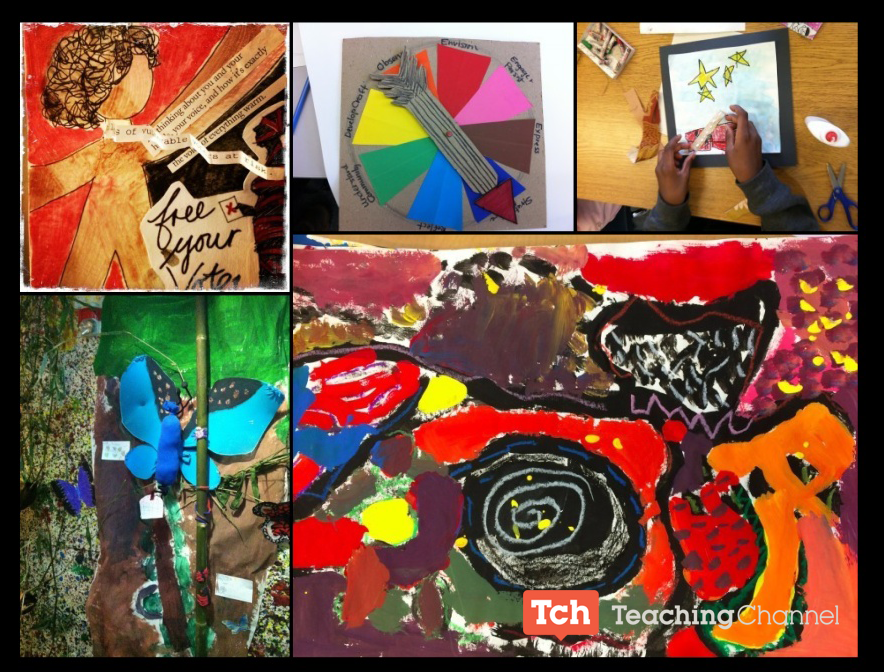By
Published
December 3, 2014
This post, authored by Mariah Rankine-Landers, first appreared on the Teaching Channel blog.
By now you have probably heard that arts integration is a thing. You might have had some coaching on how to connect an art project to a lesson, or your school may have brought back drama, dance, and the visual arts. This is all very exciting. Yet for some, we may still be wondering, “What’s the big idea with arts integration?” I’m here to help! There’s a big, wide, wonderful world of teaching in and through the arts to deepen critical thinking, collaboration, communication, and creativity.
First let’s take a peek into the broader scope of why teaching and learning through the arts is an essential foundational practice:
Critical Thinking: I’ve come to understand this: that contemporary artists embody critical thinking like a song embodies a harmony. What we have to gain from contemporary artists are The Studio Habits of Mind: Observe, Reflect, Stretch and Explore, Engage and Persist, Understand Community, Develop Craft, Envision, and Express. These habits help students develop critical thinking skills across disciplines. They are just as important for science and math as they are for the arts. They empower students to articulate their learning no matter what content is being addressed.
Collaboration: Collaboration is essential to contemporary arts and hence, contemporary education. Ideas are formed best when two or more minds meet. Students can collaborate on projects from framing research questions, to developing a mural, to writing a script for an animation on mitosis. My favorite online example of how the world is using collaboration through the arts are Joseph Gordon Levitt’s Hit Record, Episode 1, and this recent viral video on a PhD candidate’s dissertation submitted as a choreographed dance piece.
Communication: When you collaborate you have to communicate, or nothing will get done! The key to communication is empathy. Empathy is the golden key to unlocking teaching and learning in our diverse world. Artful thinking + empathy = students who are able to communicate ideas, values, and new knowledge effectively.
Creativity: Naturally, the arts drive creativity. What is not widely known is that the arts drive creative inquiry, and creative inquiry is the driver of all disciplines. It is through creative inquiry that we unlock questions, solve problems, and discover new possibilities.
“Okay, that all sounds great, but how do I actually do this?” Rather than providing you with a list of arts integration lesson ideas, consider what is at the heart of making steps towards integrating the arts:
1. Identify the arts that move you, and also who your favorite contemporary artists are. Examine what they bring to the world and how. What form do they express their ideas in? What questions do they have for the world? What is it they want you to understand as the viewer? Bring these same questions to your curriculum.
2. Develop a strategy to introduce the Studio Habits of Mind. Examine where in your life you use the habits naturally. Start to examine where you’re students engage with the habits naturally. Begin to be more explicit about when and how the students are using and forming the habits of mind.
3. Muck around and make an attempt to introduce content areas through an art form. Nothing is off limits. I’m telling you, math, science, history, writing, reading can ALL be learned through an art form. The easiest way to get started is to mimic a form you love.
4. Find a network to support your endeavors! Collaborating with others is important. Having someone to provide specific ideas and support is crucial. Find teachers who are like-minded and interested in the challenge and joy of teaching in and through the arts.
5. Find inspiration from the world around you. Go to a show at the theater, visit your local museums, attend a poetry reading, tour a few galleries in your neighborhood, engage artists in conversation about their process. Think about how you can try their approaches in your classroom.
Don’t worry that you are “off script.” That is the point of arts integration. Open up your curriculum, consider your best entry points to start and explore new ways of teaching content that will surely make learning transformative in your classroom!
Mariah Rankine-Landers is a former kindergarten and first grade teacher with 14 years of teaching experience in the classroom. Mariah holds a BA in Anthropology from UC Santa Cruz, and a MA in Equity and Social Justice in Education from SFSU. She now works for the Alameda County Office of Education as an Integrated Learning Specialist and Manager of the Integrated Learning Specialist Program, supporting the goals of equitable and transformative education for all. In addition, Mariah does educational consulting with organizations in the Bay Area. She is passionate about arts education and believes that art is a birthright. She is a resident and adoring fan of Oakland, CA and its communities.


